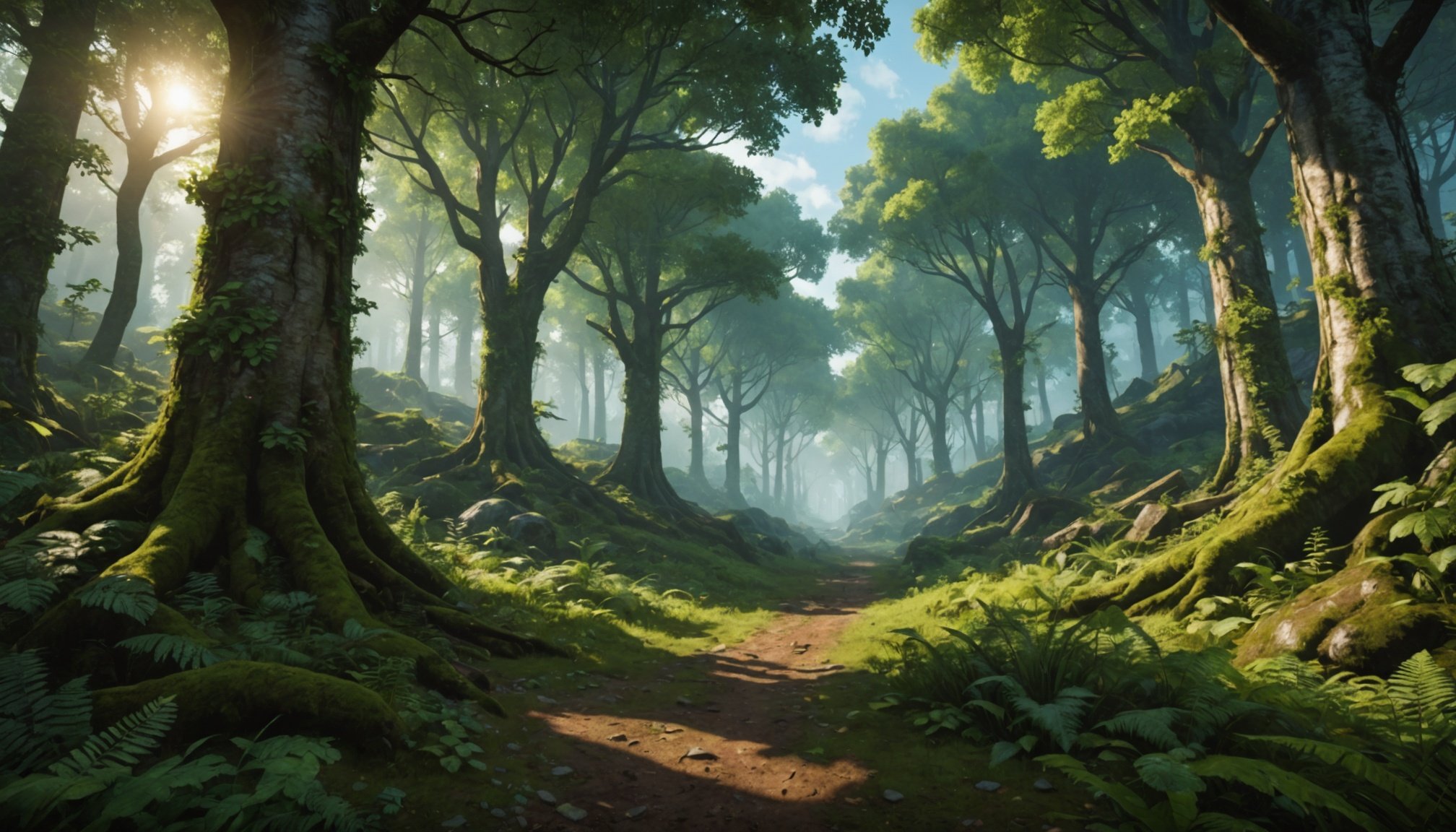Understanding the Essentials of Lush Forest Landscapes
Lush forest landscapes are a captivating feature in many exploration games, providing players with immersive environments that encourage discovery and engagement. These vivid settings are defined by their dense vegetation, diverse wildlife, and dynamic weather conditions, creating a sense of realism and intrigue. The vibrant hues of foliage and the interplay of light and shadow further enhance the player experience, making these digital worlds feel alive and inviting.
The importance of landscape in exploration gameplay cannot be overstated. It serves as both a backdrop and a character within the game, guiding players through the narrative while offering countless opportunities for exploration. These landscapes often conceal secrets and challenges that prompt players to interact with the environment in creative ways, driving the flow of the game forward.
Topic to read : Unleashing the power of neural networks: enhancing real-time object recognition in augmented reality gaming
Analyzing successful exploration games, it’s clear that immersive forests play a critical role in their appeal. Games like “The Witcher 3: Wild Hunt” and “Horizon Zero Dawn” exemplify how lush forest landscapes can enhance storytelling and gameplay mechanics. These environments not only provide aesthetic pleasure but also deepen the player’s connection to the game world, creating a memorable and engaging gaming experience.
Techniques for Crafting Immersive Forest Environments
In game design, creating captivating forest environments requires a blend of techniques that enrich the player’s experience.
Also read : Mastering multiplayer dynamics: navigating key hurdles in developing next-gen vr experiences
Layering Visual Elements
To craft an immersive forest, begin with layering visual elements. This involves a strategic use of color palettes and textures. Forests often use greens and browns, but integrating different shades can add depth. Ensure each layer, from canopy to forest floor, has distinct textures to bring realism. Introduce a variety of plants, rocks, and even wildlife models to create a dynamic space.
Incorporating Natural Sounds
Incorporating natural sounds is vital for environmental storytelling. Ambient sounds such as rustling leaves, bird calls, and distant rivers allow players to feel part of the environment. These sounds can guide players, hinting at hidden paths or dangers, enhancing overall immersion without obvious cues.
Utilizing Lighting for Atmosphere
Lighting transforms a static scene into a living one. Use lighting techniques to set mood. Soft, diffused light creates a serene, peaceful setting, while bold highlights and shadows can evoke mystery or suspense. Consider the time of day, as it affects light color and intensity. Using these strategies in forest environments ensures that players are not just seeing the game world but truly experiencing it.
Design Principles for Forest Exploration Games
When delving into game design principles for forest environments, a few elements stand out as critical for success. The ability to balance exploration with player engagement is often seen at the heart of immersive forest game settings. Levels should encourage players to wander and discover, without feeling aimless.
Successful level design involves crafting worlds where each element serves a purpose. Pathways must guide players subtly, employing natural cues like flowing streams or tree lines, easing navigation while maintaining immersion. Players should feel both a sense of direction and freedom, a delicate dance between guidance and autonomy.
Creating interaction points and landmarks also plays a vital role. These features draw players’ attention, inadvertently guiding them through the terrain while offering diverse engagement opportunities. Whether through interactive flora or fauna, the objective is to design a living, breathing world that players wish to explore further.
Ultimately, the key lies in the thoughtful blend of realism and creativity, allowing the forest environment to become a character itself, inviting players to connect with it on a deeper level. Balancing these aspects effectively is what transforms a simple setting into a captivating experience.
Environmental Storytelling in Forests
Navigating forests in video games can be an exhilarating experience, thanks to the rich elements of environmental storytelling woven into these virtual realms. World-building is essential in crafting immersive scenarios that enhance the overall player experience.
Using Props and Landmarks
Props and landmarks are powerful tools for storytelling. Large rocks, ancient trees, or abandoned campsites can serve as narrative devices. For example, a weathered sword lodged in a stone might hint at a past battle. The presence of these props enthuses players, making the experience more engaging as they piece together narrative clues.
Creating Backstories through the Environment
Environments tell stories through subtle cues incorporated into their design. The growth patterns of moss and the architecture of foliage can provide history, indicating areas that were once bustling with life or foreboding regions. This form of storytelling establishes a backstory without reliance on text, encouraging players to explore and infer the lore themselves.
Integrating Hidden Areas and Secrets
Hidden areas teem with rewards for the curious. Discoveries like secret grottos or concealed pathways not only stimulate excitement but also deepen engagement. These locations often house crucial artefacts or backstory elements, vital to the lore. Such integration elevates storytelling, ensuring each exploration leads to meaningful discovery.
Game Mechanics for Forest Exploration
Exploring virtual forests can offer immersive experiences due to diverse game mechanics that enrich engagement. Mechanics such as climbing and gliding are pivotal, enabling players to navigate the towering trees and rugged terrain effortlessly. For instance, a robust climbing mechanic allows players to scale tree trunks and cliffs, uncovering hidden paths and vantage points. Similarly, gliding between treetops provides a seamless traverse, offering breathtaking aerial views of the forest canopy.
To enhance interaction with the environment, thoughtful interaction design is crucial. This could involve crafting player tools that facilitate deeper environmental engagement. Player tools might include a grappling hook for swift movements or binoculars for spotting distant locations of interest.
Moreover, weaving challenges into the forest’s natural landscape adds depth and intrigue. Consider obstacles like dense undergrowth requiring a machete to clear paths, or puzzles where elements of the terrain must be manipulated. By integrating these challenges, the exploration feels both rewarding and demanding, keeping players dynamically involved.
By focusing on varied mechanics and interaction design, developers create rich, compelling journeys through forests, ensuring each adventure is unique and captivating.
Tools and Software for Game Development
Finding the right game development tools is crucial for creating immersive forest games. Below are some essential resources and advice for new and experienced developers.
Popular Game Engines for Forest Games
Two of the most widely used game engines for developing forest-themed environments are Unity and Unreal Engine. Unity offers a user-friendly interface, extensive asset store, and supports both 2D and 3D game development, making it ideal for lush forest settings. Unreal Engine, known for its high-quality graphics and visual scripting, is another excellent choice for achieving realistic, densely wooded environments.
Asset Creation Tools for Lush Environments
Incorporating asset creation tools can significantly enhance the realism of your game’s forests. Software like Blender and Maya can be employed to design intricate models, while tools such as Photoshop and Substance Painter are recommended for crafting detailed textures.
Resources for Tutorials and Learning
Many developers benefit from community resources and tutorial libraries. Platforms like Udemy, YouTube, and Coursera provide comprehensive guides on using these game development tools effectively. Engaging with communities on forums such as Reddit or Stack Exchange can also offer valuable insight and troubleshooting assistance. These resources make sure you’re not only equipped with the right software recommendations, but also continuously learning and improving your skills.






